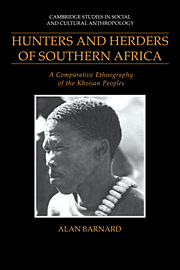Book contents
- Frontmatter
- Contents
- List of figures and maps
- List of tables
- Preface
- A note on orthography
- Part I The Khoisan peoples
- Part II A survey of Khoisan ethnography
- 3 The !Kung
- 4 The !Xõ and Eastern ≠ Hoã
- 5 The Southern Bushmen
- 6 The G/wi and G//ana of the central Kalahari
- 7 The Eastern and Northern Khoe Bushmen
- 8 The Nharo
- 9 The Cape Khoekhoe and Korana
- 10 The Nama and others
- 11 The Damara and Hai//om
- Part III Comparisons and transformations
- References
- Index
- Cambridge Studies in Social and Cultural Anthropology
7 - The Eastern and Northern Khoe Bushmen
Published online by Cambridge University Press: 05 June 2012
- Frontmatter
- Contents
- List of figures and maps
- List of tables
- Preface
- A note on orthography
- Part I The Khoisan peoples
- Part II A survey of Khoisan ethnography
- 3 The !Kung
- 4 The !Xõ and Eastern ≠ Hoã
- 5 The Southern Bushmen
- 6 The G/wi and G//ana of the central Kalahari
- 7 The Eastern and Northern Khoe Bushmen
- 8 The Nharo
- 9 The Cape Khoekhoe and Korana
- 10 The Nama and others
- 11 The Damara and Hai//om
- Part III Comparisons and transformations
- References
- Index
- Cambridge Studies in Social and Cultural Anthropology
Summary
Introduction
The boundary between the Central, and the Northern and Eastern, Khoe Bushmen is not a precise one, on either linguistic or cultural grounds. Yet like the colonial administrator, the comparative ethnographer must draw his heuristic lines on the map, and the boundaries of the Central Kalahari Game Reserve are as logical as any (see Figure 7.1). Indeed, this comparison is not as facetious as it may seem, for to a great extent these lines today do demarcate the degree of Tswana influence on the populations concerned. While the Bushmen of the C.K.G.R. have seen relatively little of the world until recent times, those of the eastern Ngamiland, the Central District, and the Kweneng (cf. Figure 6.1) have all been involved in extensive trade networks, and many have lived in close association with non-Khoisan groups for well over a century.
The culturally defined ‘Eastern Khoe bushmen’ comprise a number of groups scattered from the Kweneng District of Botswana in the south to Ngamiland in the north. Most live in the Central District, often as clients of Bantu-speaking people, including Tswana, Kgalagari, Kalanga (a group closely related to the Shona of Zimbabwe), and, more rarely, Herero. The cultural (as opposed to linguistic) distinction between Central and Eastern Khoe Bushmen is a nebulous one, and I include among ‘Eastern’ groups some G//ana who have migrated from the C.K.G.R. to take up a more settled life among the cattle herders to the south and east.
- Type
- Chapter
- Information
- Hunters and Herders of Southern AfricaA Comparative Ethnography of the Khoisan Peoples, pp. 117 - 133Publisher: Cambridge University PressPrint publication year: 1992



